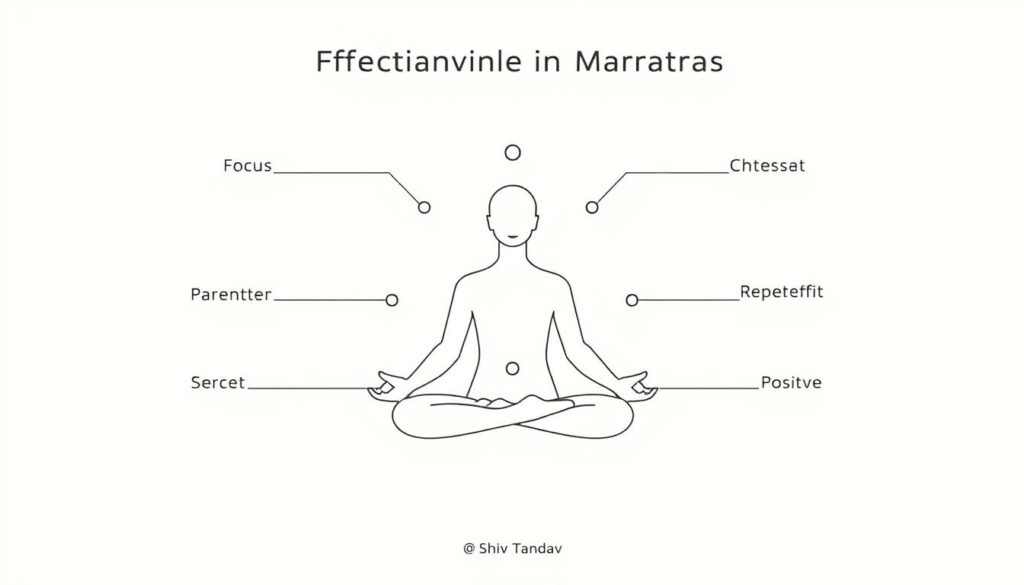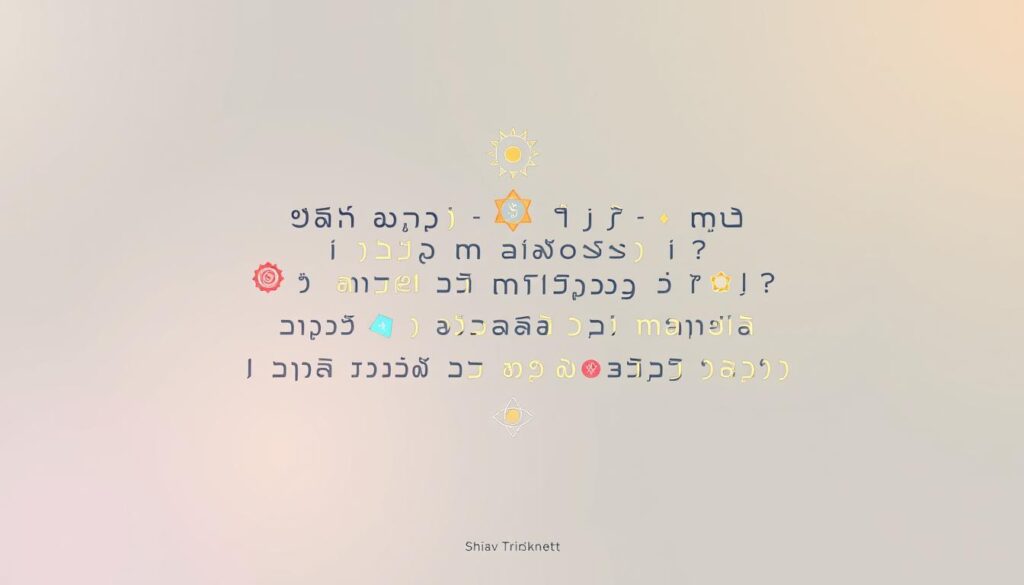
In today’s world, it’s easy to get lost in the noise. But, personal mantras can help us find our way back to ourselves. These positive affirmations guide us, reminding us of our strengths and dreams.
Priya, a young professional in India, felt overwhelmed by her job. She took a deep breath and said her mantra: “I am confident, creative, and capable of overcoming any challenge.” This simple phrase changed her mindset, filling her with purpose and determination.
Personal mantras aren’t just for big moments. They can also improve our daily lives. They can motivate us in the morning, help us stay focused during tough workouts, or comfort us when we’re stressed. These personalized affirmations deeply impact our mental and emotional health.
Key Takeaways
- Personal mantras are positive affirmations that can boost motivation, inspiration, and mental well-being.
- These mantras can be used in various situations, from daily challenges to extraordinary moments.
- Incorporating personal mantras into your routine can help you stay grounded, focused, and connected to your true self.
- Crafting a personalized mantra requires considering your values, goals, and the specific qualities you aim to embody.
- Consistent practice and adaptation of your mantra can make it a powerful tool for personal growth and transformation.
Understanding the Power of Personal Mantras

Personal mantras come from ancient Vedic traditions, over 3,000 years old in India. They were linked to specific deities in Hinduism, each with its own meaning. Today, personal mantras help people meet their unique needs and goals.
The Psychology Behind Mantra Practice
Mantras boost motivation and focus, studies show. They change brain areas linked to self-control, memory, and emotions. This improves mental health.
By saying a personal mantra often, you calm your nervous system. This lowers stress and cortisol levels.
Benefits of Daily Mantra Repetition
Using personal mantras daily brings many mental health benefits. Recent studies show an 82% drop in anxiety for those who use a mantra. Also, 43% see more productivity with a mantra.
Mantras help replace bad habits with good ones. 57% succeed in this effort.
How Mantras Shape Mental Wellness
Mantras make mental wellness better by focusing on positive thoughts. They help keep a positive mindset. This aligns with cognitive behavioral therapy, changing negative thoughts to positive ones.
64% find mantras useful for balancing work and life. This shows how ancient practices can solve today’s problems.
Knowing how mantras work and their daily benefits can improve mental health. They help achieve goals.
What Defines a Personal Mantra

A personal mantra is a special word or phrase that shows what someone believes in, their goals, and dreams. It’s different from old spiritual mantras because it’s made just for the person using it. These affirmations help with mental health, meditation, and growing as a person.
Personal mantras can be simple or complex. They must mean a lot to the person saying them. This way, they offer comfort, motivation, and inspiration every day. Saying their mantra helps people think positively, grow, and stay on track with their goals.
- Personal mantras are individualized expressions based on personal desires and experiences.
- Recommended practice includes spending 1/2 hour journaling, refining your focus, creating a declarative statement, and spending 10 minutes daily on mantra repetition.
- Multiple mantras can be created, but it’s recommended to focus on one at a time during meditation for better effectiveness.
Unlike old mantras, personal affirmations are not tied to ancient traditions. They let people use their own words and experiences to change their mindset and actions. By making a mantra that truly speaks to them, people can start a journey of self-empowerment and growth.
“Mantras are powerful tools for the mind, allowing beliefs to take root and shift mindsets over time with regular repetition.”
The Essential Components of Effective Mantras

Making a strong personal mantra needs careful thought. Good mantras start with “I” statements, asking oneself to change for the better. They use words like “limitless” and “unlimited” to open up possibilities. They also focus on specific goals or qualities to overcome doubts and challenges.
Beginning with “I” Statements
Starting with “I” makes the mantra personal and powerful. It’s a way to affirm and empower oneself. This approach encourages taking an active role in personal growth.
Using Hopeful and Open-ended Words
Words that suggest endless possibilities are key. Terms like “limitless” help expand one’s view. They make it easier to see and reach one’s highest goals.
Including Specific Qualities and Goals
Mantras should be broad but also specific. They should tackle personal doubts and challenges. This makes the mantra a focused tool for change and growth.
“Mantras were used by Brahmin priests in the Vedas during sacrifice and rituals to purify and sanctify the practices.”
By using these key elements, people can make mantras that truly empower them. This approach makes the ancient practice of mantras relevant today. It helps improve mental health and supports personal development.
How to Create Personal Mantras for Daily Use

Creating personal mantras can change your life. By making words that reflect your true self and dreams, you can tap into the power of creating mantras, daily affirmations, and personal development. It’s about finding “forever words” that show who you are and guide you to your goals.
Begin by thinking about what matters most to you. Write down words and phrases that show who you want to be and how you want to act. Choose words that motivate you to act. Try to have 4-10 mantras that are easy to remember but cover what you need and want.
- Identify your key areas of focus, such as personal growth, relationships, career, or well-being.
- Craft “I” statements that encapsulate your aspirations in each domain.
- Use hopeful and open-ended language to leave room for growth and transformation.
- Include specific qualities, traits, or goals that resonate with your authentic self.
Your personal mantras should feel like a natural part of you, not strict rules. Update them as your needs and goals change. By making this a daily habit, you’ll use creating mantras to shape your thoughts, daily affirmations to strengthen your beliefs, and personal development to reach your highest potential.
“The biggest risk is not taking any risk… In a world that’s changing really quickly, the only strategy that is guaranteed to fail is not taking risks.” – Mark Zuckerberg
Creating personal mantras is a journey of self-discovery and empowerment. By spending time on this, you’ll build a mindset that supports your growth, resilience, and well-being. Use the power of creating mantras, daily affirmations, and personal development to unlock your true potential and live your best life.
Selecting Powerful Words for Your Mantra

Choosing the right words for your mantra is key. These words shape your mindset and boost your motivation. They help you become the person you want to be.
Use words that reflect your values, dreams, and qualities you admire. This way, your mantra will deeply connect with you and guide you towards your goals.
Word Categories to Consider
- Personal values: Words that reflect your core beliefs and principles, such as “integrity,” “compassion,” or “perseverance.”
- Aspirations: Words that capture your dreams and desires, like “abundance,” “courage,” or “fulfillment.”
- Positive qualities: Words that describe the traits you wish to cultivate, such as “resilience,” “confidence,” or “adaptability.”
Avoiding Common Word Mistakes
When picking words for your mantra, avoid negative ones. Instead, choose words that uplift and inspire. Words like “can,” “will,” and “success” are great choices.
| Avoid | Choose |
|---|---|
| Doubt | Confidence |
| Struggle | Perseverance |
| Weakness | Strength |
| Fear | Courage |
By picking powerful, positive words, you create a mantra that guides you daily. Your mantra should reflect your true self. Choose words that truly resonate with you and your dreams.
The Role of Specificity in Mantra Creation

When making personal mantras, being specific is crucial. Studies show that adding details to your goals makes them more likely to happen. For instance, a study found that saying “Every penny counts” almost doubled donations.
Adding specific actions or qualities to your mantras makes them clearer and easier to reach. This precision helps your mind focus on what you truly want. It boosts your chances of personal growth and change.
- Think about what you really want and what you wish to achieve.
- Choose words that make you happy and excited, keeping it simple yet focused.
- Include positive goal-oriented affirmations in your mantra to boost your confidence.
- Repeat your mantra with purpose, really thinking about its meaning each time.
The more specific mantras you create, the more you align your thoughts and actions with your goals. This focus can deeply impact your personal growth and achieving your dreams.
“Crafting a personal manifestation mantra involves choosing words that resonate with your desires and repeating them to focus energy on specific life goals.”
Remember, the power of personal growth comes from defining and chasing your dreams with determination. By making your mantras specific, you’re taking a key step towards realizing your vision of life.
Incorporating Personal Goals into Your Mantras

Creating effective mantras is more than picking uplifting words. It’s about linking them to your personal goals and dreams. By mixing short-term and long-term goals in your mantras, you get a balanced way to grow and succeed.
Short-term vs. Long-term Goal Integration
Short-term goals give you quick motivation and a sense of progress. They keep you focused and energized every day. Adding these goals to your mantras helps you stay on track and celebrate small wins.
Long-term goals, however, give you a bigger picture. They guide you toward your ultimate success and happiness.
Making Goals Actionable Through Mantras
- To turn vague goals into real actions, add specific behaviors or steps to your mantras.
- For instance, instead of saying “I will achieve my fitness goals,” say “I am getting closer to my ideal weight every day with healthy habits.”
- This method makes you see the actions needed and boosts your chances of reaching your goals.
By mixing short-term and long-term goal-setting mantras into your daily routine, you create a strong connection. This connection between your thoughts, feelings, and actionable affirmations drives your personal achievement.
Best Times to Practice Your Personal Mantras

Adding mantra practice to your daily life can greatly improve your well-being. It’s important to find the best times to say your mantras and daily affirmations. This way, you can use these powerful words to change your life for the better.
Practicing your mantras in the morning is highly recommended. It helps set a positive mood and aligns your goals for the day. Saying your mantras before tough tasks can also give you the courage to face challenges head-on.
When you’re feeling stressed or overwhelmed, your mantras can bring calm and clarity. Just a few moments of quiet repetition can help you find balance and perspective. Using mantras at night can also help you stay focused on your goals as you sleep.
Some people like to say their mantras while doing daily activities like driving, working out, or doing chores. This makes it easier to make mantra practice a regular part of your life. It adds a sense of purpose and growth to your mindfulness routines.
“Mantras are not just words, they are vibrations that have the power to transform our consciousness and our lives.” – Deepak Chopra
Really, the best times to practice your mantras are the ones that feel right to you. Try different times and find what works best for your lifestyle. This way, you can fully experience the power of mantras for personal growth and self-discovery.
Making Your Mantras Forever Words

To make your personal mantras truly impactful, they must stay meaningful and relevant. It’s important to regularly check if your mantras still inspire you. This way, you can keep them fresh as your goals and life change.
Testing Mantra Effectiveness
See how your mantras affect your thoughts, feelings, and actions. Notice any positive changes when you repeat your affirmations. If a mantra stops working for you, it’s time to update it.
Adapting Mantras Over Time
As you grow, your needs and goals might change. Be ready to adjust your mantras to keep them relevant. Think about how your mantras have helped you and add new ones that match your current dreams.
The best mantras last a lifetime, offering constant inspiration and motivation. By updating your mantras regularly, you create lasting reminders of your growth and progress.
Using Mala Beads for Mantra Practice

Mala beads are a traditional tool for mantra meditation, made of 108 beads. They help you keep track of your mantra repetitions. This makes your practice more focused and mindful.
By holding the mala and moving it bead by bead, you can repeat your mantra 108 times. Many malas have special beads after every 27th bead. This makes it easy to practice in sets of 27.
The 108 beads in a mala have deep meaning. They are believed to connect us to joy and happiness. Malas are often knotted to show more beads and protect them.
The guru bead is the center of the mala, symbolizing the master teacher. The tassel represents our connection to the divine and others. When using mala beads, hold them correctly to keep your ego out.
Start your mantra recitation with the bead closest to the guru bead. Move around the mala, filling each bead with your mantra. For best results, use one mantra for at least 40 days to see changes.
Mala beads are a powerful tool for mantra meditation. They help you stay focused and deepen your connection to sacred words. Whether you’re new or experienced, mala beads can change your mindfulness journey.
Creating a Morning Mantra Routine

Starting your day with a morning mantra routine can be very powerful. It helps you begin with a positive mindset. By using personal mantras, you can set a tone of optimism and self-confidence for the day.
Start your day by saying your mantras 3-5 times before getting out of bed. This can deeply impact your mindset. It fills your subconscious with thoughts of strength, gratitude, and purpose.
Continue saying your mantras as you go about your morning. This could be while brushing your teeth or eating breakfast. Keep your mantras somewhere you can see them, like a mirror or bedside table. This helps you remember to pause and focus.
Being consistent is important for making morning mantras a habit. Start with 20 repetitions a day and aim for 108. After just a week, you’ll likely see a big change in how you feel and think.
By making morning mantras a part of your daily morning rituals, you can fill your mind with positive daily affirmations. This sets you up for a positive start to your day.
“Morning mantras have the power to transform your mindset and unlock a new level of productivity and confidence.”
Combining Mantras with Meditation Practice

Take your mantra practice to the next level by blending it with meditation. Use breathing techniques and set up a special space for your sessions. This will help you feel the deep connection between mantras and mindfulness, boosting your spiritual journey and overall well-being.
Breathing Techniques for Mantra Recitation
Make your mantra meditation even more powerful by matching it with your breath. Try deep belly breathing or alternate nostril breathing to focus better. As you say your mantra, let your breath carry the words in and out.
Creating Sacred Space for Practice
Have a special area for your mantra and meditation, away from distractions. It should be calm and filled with things that make you think deeply. This could be a quiet spot in your home with candles, incense, or other items that mean a lot to you.
Using mantras and meditation together is a great way to grow spiritually and be more mindful. By adding breath work and a peaceful space, your mantra meditation will get stronger. This can lead to knowing yourself better, feeling less stressed, and finding more peace inside.
“The breath is the bridge which connects life to consciousness, which unites your body to your thoughts. Whenever your mind becomes scattered, use your breath as the means to take hold of your mind again.” – Thich Nhat Hanh
Common Challenges in Mantra Practice

Starting a mantra practice can face many challenges. But, with the right mindset and strategies, you can overcome them. The main hurdles include keeping up with practice, dealing with self-doubt, and feeling awkward or skeptical at first.
Keeping up with mantra practice is often the biggest challenge. Life’s demands and distractions can make it hard. To beat this, set achievable goals and make mantra practice part of your daily routine. Use reminders and visual cues to help remember.
Self-doubt can also be a problem. It makes you wonder if your mantras are working. Remember, mantras get stronger with regular use and belief. Think about the small benefits you’ve seen to stay motivated.
Feeling awkward or skeptical is another common issue. Mantra practice might seem strange at first. Start with short sessions and learn about the science behind mantras to feel more comfortable.
By facing these challenges with patience and realistic goals, you can build a rewarding mantra practice. It will help you grow and feel better.
“The regular chanting of mantras is considered a preventative measure against inappropriate thoughts.” – American Hindu Priest Thomas Ashley-Farrand
| Challenge | Strategies |
|---|---|
| Maintaining Consistency | Set realistic practice goals Integrate mantra into daily routines Use reminders and visual cues |
| Overcoming Self-Doubt | Reflect on the benefits experienced Cultivate genuine belief in mantra power Persist with regular practice |
| Dealing with Skepticism | Approach with an open mind Learn about the science and psychology Start with short, manageable sessions |
Conclusion
Creating and using personal mantras is a powerful tool for personal growth and self-empowerment. By crafting meaningful, specific, and actionable daily affirmations, you can shape your thoughts and behaviors. This can lead to significant personal growth and increased self-awareness.
Embrace the process of creating and using personal mantras as a journey of self-discovery and empowerment. Tap into the ancient wisdom of mantras, which align the mind, body, and spirit. Explore their transformative power and how they can positively influence your well-being.
Whether you’re looking to reduce stress, enhance focus, or find inner peace, personal mantras can guide you. Start this meaningful practice and watch your personal growth and self-empowerment grow, one daily affirmation at a time.
FAQ
What are personal mantras?
Personal mantras are positive phrases used for motivation. They can be favorite quotes or affirmations. These phrases help boost your mental state in different situations.
What are the psychological benefits of mantra practice?
Mantras improve motivation, focus, and mental wellness. They also reduce stress and boost self-confidence. Mantras help shape positive thought patterns and support growth.
How are personal mantras defined?
A personal mantra is a phrase that reflects your beliefs or goals. It’s a tool for self-reflection and motivation. Mantras should reflect your values and aspirations.
What are the essential components of effective mantras?
Good mantras start with “I” and use hopeful words. They should include qualities and goals you want to achieve. This makes success feel real and attainable.
How can one create personal mantras for daily use?
Start by brainstorming words that represent you and your goals. Then, edit your list to focus on the most important words. Aim for 4-10 words that are easy to remember yet meaningful.
What should be considered when selecting words for a mantra?
Choose words that reflect your values and goals. Pick words that make you feel positive. Avoid negative words and focus on positive affirmations.
Why is specificity important in mantra creation?
Specificity makes mantras more effective. Adding specific details to your goals increases success chances. Specific mantras help turn dreams into real actions.
How should personal goals be incorporated into mantras?
Include both short-term and long-term goals in your mantras. Make goals specific by adding actions or behaviors. This turns dreams into doable steps.
When are the best times to practice personal mantras?
Practice mantras in the morning, before tough tasks, during stress, and before bed. Daily routine helps maximize mantra impact.
How can mantras become “forever words”?
Make mantras “forever words” by making them meaningful. Regularly check if they still work for you. Be ready to change them as you grow and goals change.
